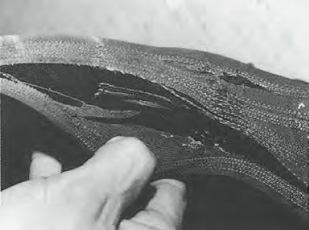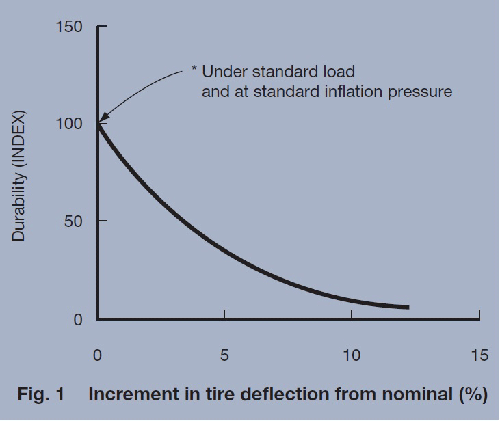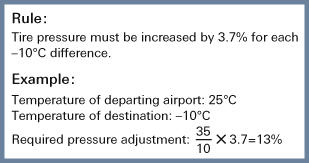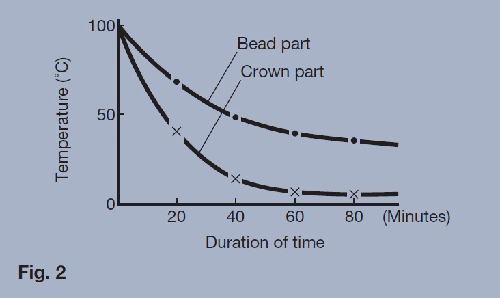Aircraft Tires
Care and Maintenance Tire Care and Maintenance
5. Inflation Pressure Control
It is recommended that inflation pressure of each aircraft tire be checked daily, and that the pressure gauge be calibrated regularly. Maintaining correct tire inflation pressure is the most important factor in any preventive maintenance program.
A. Pressure Readjustment After Installing Tire on Aircraft
PNZ (loaded service pressure) shall be used instead of the PNO, if the aircraft is on the ground.
PNZ is specified as add 4% to the PNO, to adjust the target pressure considering increase by small shrink of tire gas chamber due to vertical loading.
- Aircraft on Jacks: Readjustment pressure is PNO
- Aircraft on Wheels: Readjustment pressure is PNZ
1.04 X PNO (Unloaded)=PNZ (Loaded)
B. Pressure Control In Service
The pressure check should be done exclusively with "cold tire"; tire temperature is within a rage of ambient temperature.
If the tire is not operated for successive 3 hours or longer, the tire is granted as the "cold tire", unless otherwise exposed to direct sun light for a significant time period.
C. Normal Pressure Loss During Service
Slight pressure loss occurs with aircraft tires due to natural leakage of small amount of gas. Permissible range of the loss is 5% or less within 24 hours.
A small amount of gas diffusion through the "vent holes"; artificial holes situated at the lower sidewall, is a normal mechanism to bleed off trapped air, preventing internal separation or blistering. However, such air leakage should not be detectable by hand. If pressure is found to be less than the minimum pressure, refer to Table 3.
Table 3: Tire Pressure Verification
| Tire Pressure | Verification | Recommended Action |
|---|---|---|
| P > PN +5% | Overinflation | Readjust to maximum of normal operating range if tire is at ambient temperature. |
| PN + 5% > P > PN | Normal Operating Range | No action if within Normal Operating Range (NOR). |
| PN > P > 95%PN | Allowable Daily Pressure Loss | Reinflate to specified service pressure. |
| 95%PN > P > 90%PN | Moderate Pressure Loss | Reinflate to specified service pressure. Record in aircraft log book. Remove if pressure loss reoccurs within 24 hours. |
| 90%PN > P > 80%PN | Large Pressure Loss | Replace the tire. |
| 80%PN > P > 0 | Extreme Pressure Loss (Underinflation) |
Replace tire and its axle mate. |
| P = 0 | Complete pressure loss due to; - Tire perforation - Blown fuse plug |
Replace tire and its axle mate. |
P: Tire Pressure Reading
PN: Loaded Service Pressure
NOR: Normal Operating Range (Service Pressure)
* Please mark pressure loss tire with "tire pressure loss removal" or "low pressure".
![]() WARNING
WARNING
IF THE INFLATION PRESSURE LOSS OS MORE THAN 10%, REPLACE THE TIRE.
IF YOU RE-INFLATE AND KEEP USING THE TIRE, THERE IS A RISK OF TIRE BURSTING.
D. Identification of Axle Mate
When a tire is removed for any of the following reasons, the axle mate tire must be identified and the serial number must be provided to the appropriate retreader (Refer to Table 3).
- Large pressure loss
- Extreme pressure loss
- Perforation
- Blown fuse plugs
E. Adverse Effects of Underinflation

An example of Casing Break Up (CBU) in a bias tire at the lower sidewall caused by running the tire at pressures below those recommended.
Underinflation will cause high tire deflection and heat build-up, which in turn may lead to ply separation.
Low inflation pressure may also cause uneven wearing of the tread and rapid wearing of the shoulder. It may also increase the tire footprint, possibly leading to damage of the tire sidewall during landing.
F. Tire Deflection and Durability

Figure 1 shows the relationship between the changes in tire deflection at various inflation pressures and the durability of the tire carcass. With aircraft tires, an increase in deflection during operation greatly weakens the carcass.
G. Adverse Effects of Overinflation on Tires
Excessive inflation pressure may cause uneven tread wear (Wearing of the tread center), less braking efficiency, abnormal tire growth, and may make the tread more susceptible to cutting by foreign objects.
H. Compensation for Climate Change

When a flight is done from a warmer city to a colder city, inflation pressure becomes lower at the destination due to change in ambient temperature. If the temperature fall of 25 deg C or more is anticipated, the pressure shall be altered by using a rule shown below, prior to the take off at the origin airport. The minimum required inflation pressure must be maintained always.
I. Pressure Control for "Hot Tires"

A "Hot Tire" is defined to be a tire heated by aircraft operation (Braking) or by exposure to sunlight and having a surface temperature higher than ambient temperature by at least 30℃. A "Hot Tire" may also result from operating with an abnormally large tire deflection.
If a "Hot Tire" is identified, the following actions should be taken:
- Compare tire pressure for tires of the same gear (nose or main gear). Tire pressure should be in the same range for all tires on the same gear and always greater than PNZ. Tire pressure can be much greater than PNZ+5% after long taxiing or severe braking maneuvers. Leave the tire in service.
- Tire pressure should always be greater than PNZ. If pressure is lower than PNZ, conduct pressure verification after cooling of the tire in accordance with Table 3.
- If all tire pressures are greater than PNZ, but not all in the same range (unusually large variation), check for brake malfunctions or incorrect pressure adjustment during a previous check.
Reference: Tire cooling curve
The graph above shows a natural cooling curve (as a typical example) from a temperature of 95℃ for each the bead and crown section of the tire at a room temperature of 25℃. As compared to the crown section of the tire, the bead section cools slowly. These curves are based on typical examples obtained through bench testing. When other factors such as heat build-up from braking, etc., are taken into consideration, the cooling rate will become slower. Accordingly, the tires must be artificially cooled or else left at rest for a longer period of time.
J. Extraordinary Hot Tire
If the tire temperature is significantly higher than what experienced at normal daily operation, tire pressure investigation shall be done.
Make sure to cool down the tire/rim sufficiently before do this check.
Tires are not recommended for further use when the tire surface temperature exceeds 225℉ (107℃), or when the brake heat creates temperatures that exceed 300℉ (149℃) at points where the tire is in contact with the wheel surface.
WARNING
Never bleed off excess inflation pressure from a hot tire. Any adjustments to inflation pressure should be conducted after tires have cooled to ambient temperatures.
Category Link:
Tire Care and Maintenance
- 10. Removal by tire condition other than tread wear
11. Dismounting Bias Tires
12. Dismounting Radial Tires
13. Remounting of tires
14. Tire condition unsuitable for retreading - 15. Matching Tire Diameters
16. Tire Flat-spot
17. Protection from Contamination
18. Maintenance of Airport Surfaces - 19. Tires in Other than Aircraft Service
20. Storage of Tires
21. Handlings of tires
22. Transportation & Storage of Tire/Wheel Assemblies
23. Precautions during Unloading
24. Service Claim Memorandum

